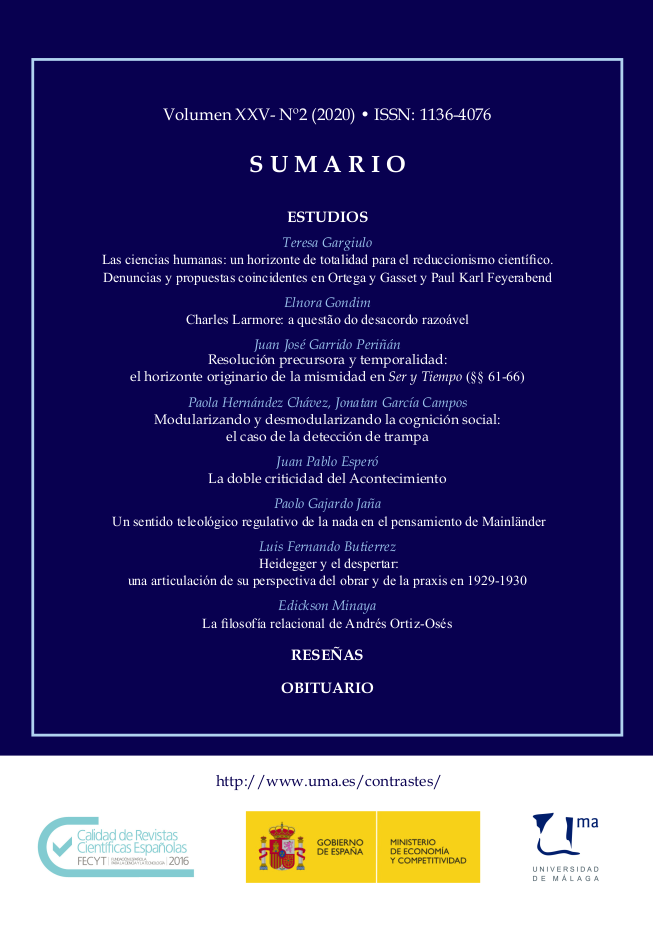Modularizando y desmodularizando la cognición social: el caso de la detección de trampa
DOI:
https://doi.org/10.24310/Contrastescontrastes.v25i2.7483Palabras clave:
cognición social, modularidad, modularidad masiva, especialización cerebral, detección de trampa.Resumen
En este trabajo, revisamos la literatura clásica en modularidad cognitiva. Ofrecemos una descripción cognitiva neuronal de la modularidad, que incluye: patrones de disfunción específicos, la doble disociación, una actividad cerebral asociada, y un proceso de especialización funcional. Posteriormente, analizamos un módulo de cognición social, i.e., el módulo de detección de tramposos. Compilamos las objeciones clásicas a este módulo, y ofrecemos algunas nuevas, para posteriormente contrastarlas con las primeras. En la última parte, ofrecemos algunas implicaciones y direcciones futuras para los estudios actuales sobre cognición social.
Descargas
Métricas
Publicación Facts
Perfil de revisores N/D
Información adicional autores
Indexado: {$indexList}
-
Indexado en
- Sociedad Académica/Grupo
- N/D
- Editora:
- Universidad de Málaga
Citas
Adams, M (2011). Modularity, theory of mind, and autism spectrum disorder. Philosophy of Science, 78, 763-773. doi:10.1086/662269.
Baron-Cohen, S., Frith, U., & Leslie, A (1985). Does the autistic child have a ‘theory of mind’?. Cognition, 21, 37-46. doi:10.1016/0010-0277(85)90022-8.
Buller, D (2005). Adapting minds: evolutionary psychology and the persistent quest for human nature. Cambridge, MA: MIT Press. https://mitpress.mit.edu/books/adapting-minds
Carruthers, P (2006). The architecture of the mind: Massive modularity and the flexibility of thought. Oxford, England: Clarendon Press. https://books.google.com.mx/books/about/The_Architecture_of_the_Mind.html?id=RUAVDAAAQBAJ&printsec=frontcover&source=kp_read_button&redir_esc=y#v=onepage&q&f=false
Cosmides, L., & Tooby, L. (1992). Cognitive adaptations for social exchange. En J. Barkow, L. Cosmides & J. Tooby (Eds.), The adapted mind: evolutionary psychology and the generation of culture (pp. 163-228). New York, NY: Oxford University Press. https://psycnet.apa.org/record/1992-98504-003.
Cosmides, L., Tooby, J., Fiddick, L., & Bryant, G (2005). Detecting cheaters. Trends in cognitive science, 9, 505-506. DOI: https://doi.org/10.1016/j.tics.2005.09.005
Cummins, D. (2000). How the social environment shaped the evolution of mind. Synthese, 122, 3-28. https://doi.org/10.1023/A:1005263825428
Dehaene, S., & Cohen, L (1991). Two mental calculation systems: A case study of severe acalculia with preserved approximation. Neuropsychologia, 29, 1045-1074. doi:10.1016/0028-3932(91)90076-k
Gerrans, P., & Stone, V (2008). Generous or parsimonious cognitive architecture? Cognitive neuroscience and theory of mind. British Journal of Philosophy of Science, 59, 121-141. https://doi.org/10.1093/bjps/axm038
Gigerenzer, G., & Hug, K (1992). Domain-specific reasoning: Social contracts, cheating, and perspective change. Cognition, 43, 127-171. DOI: 10.1016/0010-0277(92)90060-u
Elbert, T., Pantev, C., Wienbruch, C., Rockstroh, B., & Taub, E (1995). Increased cortical representation of the fingers of the left hand in string players, Science, 270, 305-307. DOI: 10.1126/science.270.5234.305
Ermer, E., Guerin, S., Cosmides, L., Tooby, J., & Miller, M (2006). Theory of mind broad and narrow: Reasoning about social exchange engages ToM areas, precautionary reasoning does not. Social Neuroscience, 1, 196-219. DOI: 10.1080/17470910600989771
Evans, J., & Over, D (1996). Rationality and reasoning, East Sussex, England: Psychology Press. https://doi.org/10.1016/0010-0277(93)90039-X
Fodor, J. (1983). The modularity of mind: An essay on faculty psychology, Cambridge, MA: MIT Press. DOI: https://doi.org/10.1017/CBO9780511814273.046
Hernández-Chávez, Paola (2016), Modularidad cognitiva y especialización cerebral (2016), CEFPSVLT-SEP. Mexico. https://www.academia.edu/33396673/Modularidad_Cognitiva_y_Especialización_Cerebral
Karmiloff-Smith, A (2011). Static snapshots versus dynamic approaches to genes, brain, cognition, and behavior in neurodevelopmental disabilities. International review of research in developmental disabilities: early development in neurogenetic disorders, 40, 1-15. https://doi.org/10.1016/B978-0-12-374478-4.00001-0
Machery, E (2007). Massive modularity and brain evolution. Philosophy of Science, 74, 825-838. https://doi.org/10.1086/525624
Maguire, E. A., Gadian, D. G., Johnsrude, I. S., Good, C. D., Ashburner, J., Frackowiak, R. S., & Frith, C. D. (2000). Navigation-related structural change in the hippocampi of taxi drivers. Proceedings of the National Academy of Sciences, 97(8), 4398-4403. https://doi.org/10.1073/pnas.070039597
Mill, J. S (1882). A system of Logic, New York, NY: Harper & Brother Publishers. https://www.gutenberg.org/files/26495/26495-pdf.pdf
Mithen, S (1996). The prehistory of mind: a search for the origins of art, religion, and science, London, England: Thames and Hudson. https://www.journals.uchicago.edu/doi/abs/10.1086/jar.52.4.3630315
Parsons, L., & Osherson, D (2001). New evidence for distinct right and left brain systems for deductive versus probabilistic reasoning. Cerebral Cortex, 11, 954-965. https://doi.org/10.1093/cercor/11.10.954
Patterson, L., & Kay, J (1982). Letter-by-letter reading: Psychological descriptions of a neurological syndrome, Quarterly Journal of Experimental Psychology, 34, 411-441. https://doi.org/10.1080/14640748208400852
Polk, T., & Hamilton, J (2006). Reading, writing, and arithmetic in the brain: Neural specialization for acquired functions, En P. Baltes, P. Reuter-Lorenz & F. Rosler (Eds.), Lifespan Development and Brain: The perspective of biocultural co-constructivism (pp. 183-199). New York, NY: Cambridge University Press. DOI: 10.1017/CBO9780511499722.010
Pinker, S (1994) The language instinct: how the mind creates language. New York, NY: HarperCollins Publishers. https://stevenpinker.com/publications/language-instinct
Ptito, M., & Desgent, S. (2006). Sensory input-based adaptation and brain architecture. En P. Baltes, P. Reuter-Lorenz & F. Rosler (Eds.), Lifespan Development and Brain: The perspective of biocultural co-constructivism (pp. 111-133). New York, NY: Cambridge University Press. DOI: 10.1017/CBO9780511499722.007
Sperber, D. (1994). The modularity of thought and the epidemiology of representations. En L. Hirschfeld & S. Gelman (Eds.), Mapping the mind: Domain specificity in cognition and culture (pp. 39-67). Ney York, NY: Cambridge University Press. DOI: https://doi.org/10.1017/CBO9780511752902.003
Sperber, D. (2002). In defense of massive modularity. En I. Dupoux (Ed.), Language, Brain, and Cognitive Development (pp. 47-57). Cambridge, MA: MIT Press. http://www.dan.sperber.fr/wp-content/uploads/2001_in-defense-of-massive-modularity.pdf
Descargas
Publicado
Cómo citar
Número
Sección
Licencia
Esta revista provee acceso libre inmediato a su contenido bajo el principio de hacer disponible gratuitamente la investigación al público. Todos los contenidos publicados en Contrastes. Revista internacional de Filosofía, están sujetos a la licencia Creative Commons Reconocimento-NoComercia-Compartirigual 4.0 cuyo texto completo puede consultar en <http://creativecommons.org/licenses/by-nc-sa/4.0>
Es responsabilidad de los autores/as obtener los permisos necesarios de las imágenes que están sujetas a derechos de autor.
Los autores/as cuyas contribuciones sean aceptadas para su publicación en esta revista conservarán el derecho no exclusivo de utilizar sus
contribuciones con fines académicos, de investigación y educativos,
incluyendo el auto-archivo o depósito en repositorios de acceso abierto de cualquier tipo.
La edición electrónica de esta revista esta editada por la Editorial de la
Universidad de Málaga (UmaEditorial), siendo necesario citar la procedencia en cualquier reproducción parcial o total.










5.png)
